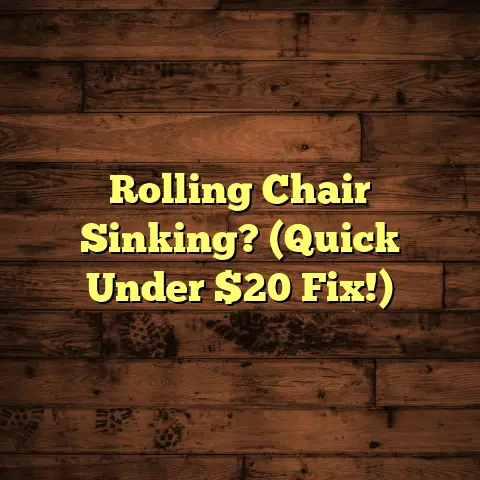Keep Carpets New: Pro Secrets? (10x Life Extender!)
Would you rather sink your toes into a plush, inviting carpet that feels brand new, or trudge across a tired, worn-out rug that’s lost its luster?
I know which one I’d pick!
It’s not just about comfort, though. It’s about maintaining a beautiful, healthy home. And that’s why I’m sharing pro secrets to keep your carpets looking newer, longer – potentially 10 times longer!
Think of your carpet as an investment. With the right care, you can protect that investment and enjoy its beauty for years to come. Let’s dive in and discover how!
Section 1: Understanding Carpet Types and Their Care Needs
Ever wonder why some carpets seem to last forever while others wear out quickly? A lot of it comes down to the type of carpet you have.
Let’s break down some common materials:
-
Nylon: This is the workhorse of carpets. It’s durable, resilient, and resists staining. I often recommend nylon for high-traffic areas.
-
Polyester: Polyester is more budget-friendly and comes in vibrant colors. It’s not as durable as nylon but still a good choice for low-traffic areas.
-
Wool: Ah, wool! It’s luxurious, natural, and incredibly soft. But, it can be more delicate and requires specialized cleaning.
-
Olefin (Polypropylene): This is a synthetic fiber that’s resistant to moisture and mold. I’ve seen it used a lot in basements and outdoor carpets.
Knowing your carpet type is crucial. You wouldn’t use the same cleaning products on wool as you would on nylon, right?
Also, consider the construction.
-
Loop pile: Think Berber carpets. These are durable and great for hiding dirt. But they can be tricky to clean if something gets stuck in the loops.
-
Cut pile: This includes textures like plush, Saxony, and frieze. They are softer but can show wear and tear more easily.
Pro Tip: Check the manufacturer’s label for specific cleaning instructions. This is your golden ticket to avoiding costly mistakes!
Section 2: Essential Tools for Carpet Maintenance
Okay, let’s talk tools! You wouldn’t build a house without the right hammer, and you can’t keep your carpets pristine without the right equipment.
Here are my must-haves:
-
Vacuum Cleaner: This is your first line of defense. Invest in a good one! I recommend a vacuum with strong suction, a HEPA filter (for allergies!), and adjustable height settings.
-
Carpet Brush: A stiff-bristled brush is essential for loosening embedded dirt and debris. I use it before vacuuming to really get things moving.
-
Stain Removers: Accidents happen! Keep a variety of stain removers on hand, specifically formulated for different types of stains.
-
Microfiber Cloths: These are fantastic for blotting up spills without spreading them.
-
Spray Bottle: For applying stain removers and DIY cleaning solutions.
-
Carpet Rake: These help to fluff up the carpet pile and remove pet hair.
Now, about cheap versus high-quality equipment… It’s tempting to save a few bucks, but trust me, it’s worth investing in quality.
A cheap vacuum cleaner might lose suction quickly, leaving dirt behind. A flimsy carpet brush could damage your carpet fibers.
Choosing the Right Vacuum:
- For plush carpets: Look for a vacuum with adjustable height settings and a brush roll that can be turned off to avoid damaging the fibers.
- For loop pile carpets: Choose a vacuum with strong suction but no beater bar, as the beater bar can snag the loops.
- For pet owners: Opt for a vacuum with powerful suction and specialized pet hair attachments.
Section 3: Regular Cleaning Routines
Consistency is key when it comes to carpet cleaning. Think of it like brushing your teeth – you wouldn’t skip it for months, would you?
A consistent cleaning schedule prevents dirt from becoming deeply embedded in the fibers, which can lead to permanent damage.
Vacuuming Effectively:
- Frequency: Aim to vacuum high-traffic areas at least twice a week, and the rest of the carpet once a week.
- Technique: Vacuum slowly and deliberately, overlapping each pass to ensure you’re picking up all the dirt and debris.
- Direction: Vacuum in multiple directions to lift the carpet fibers and dislodge dirt from deep within.
- Empty the bag/canister regularly: A full bag or canister reduces suction power, making your vacuum less effective.
Professional Cleaning Services:
I always recommend professional carpet cleaning at least once a year, even with regular vacuuming. Professionals have powerful equipment and specialized cleaning solutions that can remove deep-down dirt and allergens that your vacuum cleaner can’t reach.
When to Consider Professional Cleaning:
- High-traffic areas: If you have areas that get a lot of foot traffic, professional cleaning can help to revitalize them.
- Pet owners: Pets can bring in dirt, allergens, and odors that are difficult to remove with regular vacuuming.
- Allergies: Professional cleaning can remove allergens like dust mites and pollen, improving indoor air quality.
- Before and after events: If you’re hosting a party or have just finished a renovation project, professional cleaning can help to restore your carpets to their original condition.
Section 4: Spot Cleaning and Stain Removal Techniques
Spills happen. It’s a fact of life. But knowing how to react quickly and effectively can save your carpet from permanent damage.
Common Household Stains and How to Treat Them:
- Wine: Blot immediately with a clean cloth. Then, apply a mixture of cold water and dish soap. Blot again and repeat until the stain is gone.
- Pet Stains: Act fast! Absorb as much liquid as possible with paper towels. Then, use an enzymatic cleaner specifically designed for pet stains. These cleaners break down the enzymes in the stain, eliminating odors and preventing resoiling.
- Mud: Let the mud dry completely. Then, vacuum it up. If a stain remains, blot with a mixture of water and vinegar.
- Coffee: Blot with a clean cloth. Then, apply a mixture of water and white vinegar. Blot again and repeat until the stain is gone.
DIY Stain Removers:
I’ve got a few tricks up my sleeve for whipping up stain removers using common household ingredients:
- Baking Soda Paste: Mix baking soda with a little water to form a paste. Apply it to the stain, let it dry, and then vacuum it up. This is great for absorbing odors and lifting stains.
- Vinegar Solution: Mix equal parts white vinegar and water in a spray bottle. Spray it on the stain, let it sit for a few minutes, and then blot it up with a clean cloth. Vinegar is a natural disinfectant and can help to remove many types of stains.
- Dish Soap Solution: Mix a few drops of mild dish soap with warm water. Apply it to the stain, let it sit for a few minutes, and then blot it up with a clean cloth. Dish soap is effective for removing greasy stains.
Professional Secrets for Tackling Stubborn Stains:
- Always blot, never rub: Rubbing can spread the stain and damage the carpet fibers.
- Work from the outside in: Start at the edge of the stain and work your way towards the center to prevent it from spreading.
- Test in an inconspicuous area first: Before applying any cleaning solution to the stain, test it in a hidden area of the carpet to make sure it doesn’t damage the fibers or discolor the carpet.
- Be patient: Some stains may require multiple treatments to remove completely.
- Don’t give up! If you’ve tried everything and the stain is still there, call a professional carpet cleaner. They have specialized equipment and cleaning solutions that can often remove even the most stubborn stains.
Section 5: Preventative Measures to Extend Carpet Life
An ounce of prevention is worth a pound of cure, right? That saying definitely applies to carpet care.
Furniture Placement and Area Rugs:
- Rotate your furniture: This helps to distribute wear and tear evenly across the carpet.
- Use furniture pads: Place furniture pads under the legs of your furniture to prevent them from indenting the carpet fibers.
- Area rugs: Area rugs are a great way to protect high-traffic areas and add style to your home. Place them in hallways, entryways, and living rooms to protect the carpet underneath.
Mats and Runners:
- Entryway mats: Place mats at all entrances to your home to trap dirt and debris before they get onto your carpets. I recommend both indoor and outdoor mats for maximum protection.
- Hallway runners: Runners can protect your carpets in hallways and other high-traffic areas.
Protective Treatments:
- Carpet protectors: These treatments create a barrier that repels dirt and stains, making it easier to clean up spills. I recommend applying a carpet protector to new carpets and reapplying it every 6-12 months.
- Stain-resistant treatments: These treatments are applied to the carpet fibers during manufacturing to make them more resistant to staining. If you’re buying a new carpet, consider choosing one with a stain-resistant treatment.
Section 6: The Role of Humidity and Temperature Control
Did you know that the environment in your home can affect your carpets? It’s true!
Humidity:
- High humidity: Can lead to mold and mildew growth in your carpets. This can cause unpleasant odors and damage the carpet fibers.
- Low humidity: Can cause the carpet fibers to become brittle and crack.
Temperature:
- Extreme temperatures: Can cause the carpet fibers to expand and contract, which can lead to damage.
Tips for Maintaining Optimal Humidity and Temperature Levels:
- Use a dehumidifier: In humid climates, a dehumidifier can help to keep the humidity levels in your home under control.
- Use a humidifier: In dry climates, a humidifier can help to add moisture to the air.
- Use air conditioning: Air conditioning can help to regulate the temperature in your home and prevent extreme temperature fluctuations.
- Open windows: Opening windows can help to ventilate your home and reduce humidity levels.
Impact of Seasonal Changes:
- Summer: High humidity and increased foot traffic can lead to more dirt and stains on your carpets.
- Winter: Dry air and increased use of heating systems can cause the carpet fibers to become brittle and crack.
- Spring and Fall: Seasonal allergies can lead to more dust and pollen accumulating in your carpets.
Section 7: Repairing Minor Damage
Even with the best care, carpets can sometimes suffer minor damage. But don’t panic! Many common issues can be fixed with a little DIY know-how.
Common Carpet Issues:
- Fraying edges: This can be caused by wear and tear or improper installation.
- Pulls and snags: These can be caused by pets, children, or sharp objects.
- Burns: These can be caused by cigarettes, irons, or other hot objects.
- Ripples and wrinkles: These can be caused by improper installation, humidity, or heavy furniture.
DIY Carpet Repair:
- Fraying edges: Use a seam sealant to prevent further fraying. You can also trim the frayed edges with scissors.
- Pulls and snags: Carefully trim the pulled or snagged fibers with scissors. Avoid pulling on them, as this can damage the surrounding fibers.
- Burns: If the burn is small, you may be able to repair it by carefully trimming the damaged fibers and gluing in new fibers from a hidden area of the carpet, such as a closet.
- Ripples and wrinkles: You may be able to remove ripples and wrinkles by stretching the carpet with a carpet stretcher.
When to Call a Professional:
- Extensive damage: If the damage is extensive or you’re not comfortable repairing it yourself, it’s best to call a professional carpet repair service.
- Water damage: Water damage can lead to mold and mildew growth, which can be harmful to your health. If your carpet has been water damaged, it’s important to call a professional water damage restoration company as soon as possible.
- Structural issues: If the damage is caused by structural issues, such as a foundation problem, it’s important to address the underlying issue before repairing the carpet.
Section 8: Long-Term Carpet Care Strategies
Let’s think long-term. It’s not just about quick fixes; it’s about creating habits that extend the life of your carpets for years to come.
Caring for Carpets During Renovations or Moving:
- Cover your carpets: Protect your carpets with plastic sheeting or drop cloths to prevent them from getting dirty or damaged during renovations or moving.
- Remove furniture: Remove all furniture from the room before starting any work.
- Vacuum regularly: Vacuum the carpets regularly to remove dust and debris.
- Professional cleaning: Consider having your carpets professionally cleaned after the renovation or move is complete.
Seasonal Deep Cleaning:
- Spring cleaning: This is a great time to deep clean your carpets and remove any dirt and allergens that have accumulated over the winter.
- Fall cleaning: This is a good time to prepare your carpets for the winter months by removing any dirt and stains.
Regular Professional Cleanings:
- Frequency: I recommend having your carpets professionally cleaned at least once a year, or more often if you have pets or allergies.
- Benefits: Professional cleaning can remove deep-down dirt and allergens, extend the life of your carpets, and improve indoor air quality.
Section 9: Eco-Friendly Carpet Care Options
Want to keep your carpets clean and protect the environment? It’s totally possible!
Eco-Friendly Cleaning Products:
- Plant-based cleaners: Look for cleaning products that are made with plant-based ingredients and are free of harsh chemicals.
- Enzyme cleaners: Enzyme cleaners are effective for removing stains and odors without using harsh chemicals.
- DIY cleaning solutions: You can make your own eco-friendly cleaning solutions using ingredients like vinegar, baking soda, and lemon juice.
Sustainable Carpet Maintenance:
- Vacuum regularly: Regular vacuuming can help to reduce the need for chemical cleaning products.
- Spot clean stains: Spot cleaning stains as soon as they happen can prevent them from becoming permanent and requiring more aggressive cleaning methods.
- Use natural cleaning methods: Use natural cleaning methods like steam cleaning and baking soda to clean your carpets without using harsh chemicals.
Eco-Friendly Carpets:
- Natural fibers: Look for carpets made with natural fibers like wool, cotton, and jute.
- Recycled materials: Choose carpets made with recycled materials like plastic bottles or recycled carpet fibers.
- Low-VOC carpets: Choose carpets that are certified low-VOC (volatile organic compounds) to reduce indoor air pollution.
Section 10: Conclusion – Your Path to Long-Lasting Carpets
We’ve covered a lot of ground here, from understanding carpet types to eco-friendly cleaning options.
The key takeaway? Consistent, informed care is the secret to keeping your carpets looking new for years to come.
By adopting these professional secrets, you’re not just cleaning your carpets; you’re investing in a cleaner, healthier, and more beautiful home.
Don’t be intimidated by the amount of information. Start small, make gradual changes, and find what works best for you and your lifestyle.
Remember, a little effort goes a long way in preserving the beauty and extending the life of your carpets. Now go forth and conquer those carpets!





